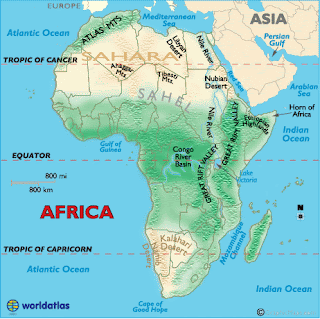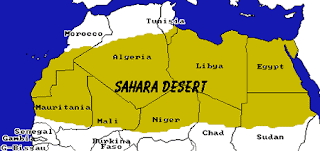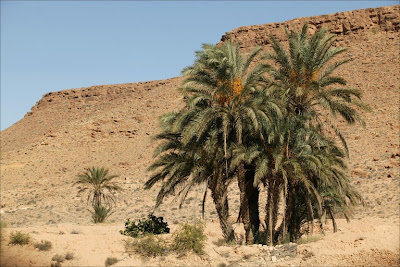Introduction
 |
| Map of African Continent [1]. |
 |
| Saharan Desert in Africa [2]. |
History
 Some 10,500 years ago, there was a sudden strengthening of monsoonal rains that occurred in the Sahara Desert. Many scientists believe that this was a result of a change in Earth’s orbital shift. This increased precipitation ultimately replenished the land, making it habitable and more-Savanna like (4). It created a "green Sahara" (5). Thus, Nile Valley dwellers began to settle in this region. Southwestern Egyptian rock art and human and animal remains from various excavation sites have served as evidence that the new semi-arid conditions encouraged human and animal inhabitance. Unbroken sediments in Saharan waters like Lake Chad also served as evidence of a lusher Sahara thousands of years ago (4). Scientists have also retrieved evidence from Lake Yoa about this mid-Holocene aridification. However, it should be kept in mind that there is debate over the Sahara's potential savanna-like history. Some have claimed their models and evidence shows this occurrence happening abruptly, while others have stimulated models showing a gradual change (5).
Some 10,500 years ago, there was a sudden strengthening of monsoonal rains that occurred in the Sahara Desert. Many scientists believe that this was a result of a change in Earth’s orbital shift. This increased precipitation ultimately replenished the land, making it habitable and more-Savanna like (4). It created a "green Sahara" (5). Thus, Nile Valley dwellers began to settle in this region. Southwestern Egyptian rock art and human and animal remains from various excavation sites have served as evidence that the new semi-arid conditions encouraged human and animal inhabitance. Unbroken sediments in Saharan waters like Lake Chad also served as evidence of a lusher Sahara thousands of years ago (4). Scientists have also retrieved evidence from Lake Yoa about this mid-Holocene aridification. However, it should be kept in mind that there is debate over the Sahara's potential savanna-like history. Some have claimed their models and evidence shows this occurrence happening abruptly, while others have stimulated models showing a gradual change (5). |
| 5,000-8,000 year-old Saharan rock art depicting domesticated cows [3]. |
Various grasses, shrubs, and some trees were able to sprout. These particularly occurred near valleys and groundwater sources. In LiveScience’s article “Sahara Desert Was Once Lush and Populated” and according to Stefan Kroepelin of the University of Cologne in Germany, the Sahara Desert even “included very demanding species such as elephants, rhinos, hippos, crocodiles, and more than 30 species of fish” (6). After about 5,000 years, the monsoonal rains began to retreat, resulting in drier land, ultimately transforming the once savanna-like Sahara into the desert it is today, also resulting in a decline of human in-habitation.
Benefits, Human Impact, and Conservation Status
There is little benefit people get from the Sahara Desert, especially with such limited water sources. It has two permanent rivers, the Nile and the Niger (2). Its one lake of drinkable water is Lake Chad, and occasionally the aquifers below the surface discharge waters to produce oases. It has one of the world’s most severe climates, so typically the Sahara landscape and species richness is quite limited due to no rainfall, vast winds, and altering temperatures. Only 500 species are currently included in the Sahara’s population. The dunes can be seen from the Sahara and the harshest winds originate from this desert. It acts as a connection between various countries and regions, as it covers nearly all of Mauritania, Western Sahara, Libya, Egypt, Tunisia, Niger, Mali, Chad, and Sudan (2). As far as its benefits, it is commonly known as one of the “most unforgiving lands in the world.” In terms of human impacts, since the Sahara Desert has a severe climate and is relatively Recently, oil rigs have been placed near Algeria. Oil rigs are locations where drilling for oil takes place (7).
However there has been a more recent and more prominent discovery of human impacts on this ecosystem-climate change and global warming. Humans have indirectly impacted the Sahara with their increasing growing ecological footprint. There is no question that overall temperatures of Earth are increasing (8).
Likely Future Prospects
It should be noted that there is a great debate on future environmental changes in Africa. As mentioned in a National Geographic article by Martin Calussen of the Max Planck Institute for Meteorology in Hamburg, Germany, “Forecasting how global warming will affect the region is complicated by its vast size and the unpredictable influence of high-altitude winds that disperse monsoon rains” (9).
On one hand, it is speculated that climate change may impact the Sahara positively: It may receive more rainfall, as hot air has more capacity to hold moisture resulting in more precipitation, and in turn “re-green” the Sahara (9).
On the other hand, some scientists have produced data showing a speculated decrease in rainfall- in a region that already receives extremely low precipitation in itself (9).
However, one thing is certain- the Sahara Desert has a history of instability in environmental changes, as demonstrated with the discovery that the Sahara was a savanna at one time thousands of years ago. This ecosystem has a history of contracting and expanding in size with no clear pattern.
The following graph and accompanying data table shows the instability of precipitation in the Sahara. From 1980 to 1984 there was a general decline in mean annual precipitation departure with a sudden two year spike and a sudden downturn from 1986-1987. This volatility is shown throughout 1980 to 1990, thus demonstrating that predicting annual precipitation is very difficult. There seems to be no specific pattern.
 |
| Expansiona and Contraction of the Sahara Desert [4]. |
Maintaining Balance
As global warming and climate change seems to be an indirect human impact on not only most ecosystems, but the Sahara Desert as well (whether positively or negatively), it is suggested that more proactive preventative measures are ensued. Since there is great debate on future environmental changes in Africa, it is recommended that time and energy is devoted in educating Saharan habitants and nomads on adapting to their arid surroundings. RAIN is a non-profit organization which is dedicated to engaging African communities to adapting and practice sustainable agriculture in a dry eco-region and developing their communities (10). More information about this organization can be found on their website www.rain4sahara.org. Perhaps the Sahara will begin to receive more rainfall and become greener as some scientists have speculated, or perhaps it will develop more severe weather and higher temperature variation extremes. However, it is suggested that there is a focus on teaching the inhabitants and nomads to adapt to their environment because there is no question that the Sahara has been dry for a very long time.
Thanks for reading!











